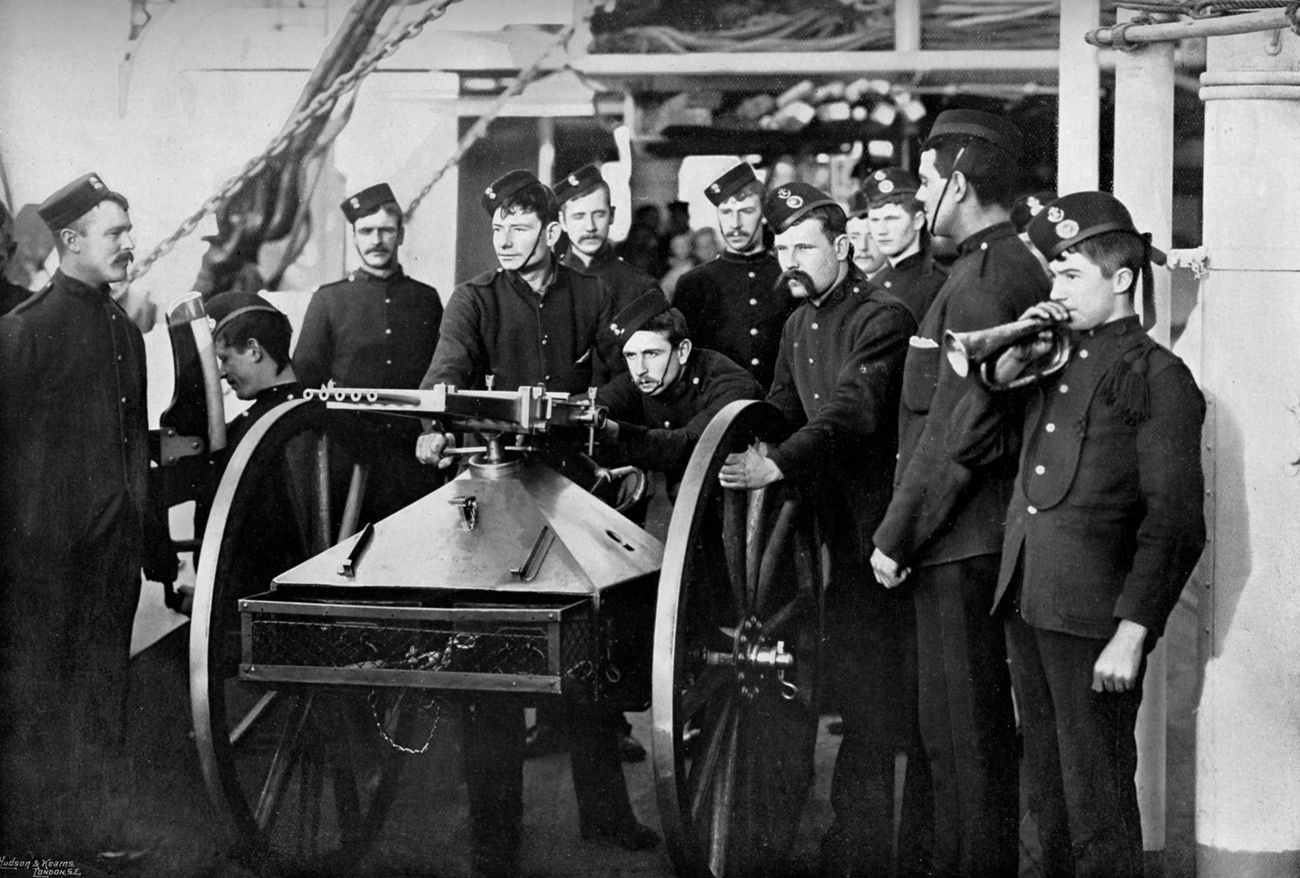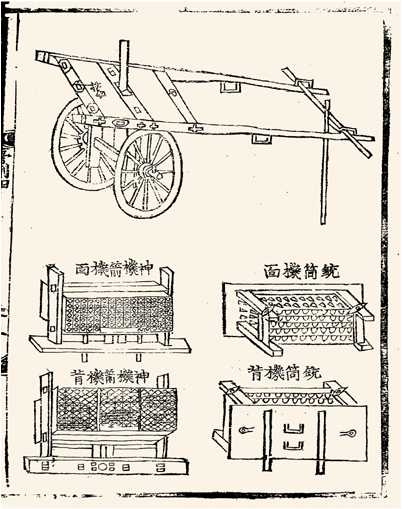|
Organ Gun
A ribauldequin, also known as a rabauld, randy, ribault, ribaudkin, infernal machine or organ gun, was a late medieval volley gun with many small-caliber iron barrels set up parallel on a platform, in use in medieval and early modern Europe during the Renaissance period. The name ''organ gun'' comes from the resemblance of the multiple barrels to a pipe organ. When the gun was fired, multiple barrels discharged their projectiles at once, yielding a much higher rate of fire than single-barrel (typically larger-caliber) guns. Organ guns were lighter and more mobile than most previous artillery pieces, making them more suitable for engaging enemy personnel rather than fixed fortifications such as castles. As an early type of multiple-barrel firearm, the ribauldequin is sometimes considered the predecessor of the 19th century mitrailleuse. History The first known ribauldequin was used by the army of Edward III of England in 1339 in France during the Hundred Years' War. Edward's r ... [...More Info...] [...Related Items...] OR: [Wikipedia] [Google] [Baidu] |
Duchy Of Milan
The Duchy of Milan (; ) was a state in Northern Italy, created in 1395 by Gian Galeazzo Visconti, then the lord of Milan, and a member of the important Visconti of Milan, Visconti family, which had been ruling the city since 1277. At that time, it included twenty-six towns and the wide rural area of the middle Padan Plain east of the Montferrat, hills of Montferrat. During much of its existence, it was wedged between House of Savoy, Savoy to the west, Republic of Venice to the east, the Old Swiss Confederacy, Swiss Confederacy to the north, and separated from the Mediterranean by the Republic of Genoa to the south. The duchy was at its largest at the beginning of the 15th century, at which time it included almost all of what is now Lombardy and parts of what are now Piedmont, Veneto, Tuscany, and Emilia-Romagna. Under the House of Sforza, Milan experienced a period of great prosperity with the introduction of the silk industry, becoming one of the wealthiest states during the Ren ... [...More Info...] [...Related Items...] OR: [Wikipedia] [Google] [Baidu] |
Medieval Artillery
Gunpowder artillery in the Middle Ages primarily consisted of the introduction of the cannon, large tubular firearms designed to fire a heavy projectile over a long distance. Guns, bombs, rockets and cannons were first History of science and technology in China, invented in China during the Han dynasty, Han and Song dynasty, Song dynasties and then later spread to Europe and the Middle East during the period. Although gunpowder was known in Europe during the High Middle Ages due to the usage of guns and explosives by the Mongol Empire, Mongols and the Gunpowder weapons in the Song dynasty, Chinese firearms experts employed by them as Mercenary, mercenaries during the Mongol invasion of Europe, Mongol conquests of Europe, it was not until the Late Middle Ages that European versions of cannons were widely developed. Their use was also first documented in the Middle East around this time. English cannons first appeared in 1327, and later saw more general use during the Hundred Year ... [...More Info...] [...Related Items...] OR: [Wikipedia] [Google] [Baidu] |
1339
Year 1339 (Roman numerals, MCCCXXXIX) was a common year starting on Friday of the Julian calendar. Events January–December * June – Battle of Laupen: The Canton of Bern defeats the forces of Fribourg. * September 18 – Emperor Go-Murakami accedes to the throne of Japan. * September 24 (or 28) – Simone Boccanegra is elected, as the first Doge of Genoa. Date unknown * Shams-ud-Din Shah Mir, having defeated Kota Rani, Hindu queen regnant of Kashmir, in battle at Jayapur (modern Sumbal), asks her to marry him, but she commits suicide rather than do so; thus he takes over sole rule of Kashmir, beginning the Muslim Shah Mir Dynasty. * All streets in the city of Florence are Pavement (material), paved, the first European city in post-Roman times where this has happened. * The Moscow Kremlin is first referred to as a Kremlin (fortification), kremlin. Births * July 23 – Louis I, Duke of Anjou (d. 1384) * November 1 – Rudolf IV, Duke of Austri ... [...More Info...] [...Related Items...] OR: [Wikipedia] [Google] [Baidu] |
AAI In-Line
The AAI In-Line was a prototype aircraft machine gun developed by AAI Corporation. The weapon was intended for potential aircraft use and capable of high rate of fire similar to the M134 Minigun but with the accuracy of a fixed barrel machine gun. The In-Line machine gun concept worked and passed air force tests but was not further developed. Around three of them were manufactured. The only known example is on display at the Air Force Armament Museum The Air Force Armament Museum is a military aviation museum adjacent to Eglin Air Force Base in Valparaiso, Florida, dedicated to the display of Air Force armament. It is supported by the private, non-profit Air Force Armament Museum Foundation .... Design The AAI In-Line is an externally driven chain/crankshaft operated machine gun with six fixed barrels. The belt feed is unusual as it uses a synchronizer for every sixth round is to be chambered in each barrel. It is chambered in 7.62×51mm NATO. References AAI In-Line [...More Info...] [...Related Items...] OR: [Wikipedia] [Google] [Baidu] |
Nordenfelt Gun
The Nordenfelt gun was a multiple-barrel organ gun that had a row of up to twelve barrels. It was fired by pulling a lever back and forth and ammunition was gravity fed through chutes for each barrel. It was produced in a number of different calibres up to . Larger calibres were also used, but for these calibres the design simply permitted rapid manual loading rather than true automatic fire. This article covers the anti-personnel rifle-calibre (typically ) gun. Development The weapon was designed by a Swedish engineer, Helge Palmcrantz. He created a mechanism to load and fire a multiple barreled gun by simply moving a single lever backwards and forwards. It was patented in 1873. Production of the weapon was funded by a Swedish steel producer and banker (later weapons maker) named Thorsten Nordenfelt, who was working in London. The name of the weapon was changed to the Nordenfelt gun. A plant producing the weapon was set up in England with sales offices in London and lon ... [...More Info...] [...Related Items...] OR: [Wikipedia] [Google] [Baidu] |
Gardner Gun
The Gardner gun was an early type of mechanical machine gun. It had one, two or five barrels, was fed from a vertical magazine or hopper and was operated by a crank. When the crank was turned, a feed arm positioned a cartridge in the breech, the bolt closed and the weapon fired. Turning the crank further opened the breechblock and extracted the spent case. Development The Gardner machine gun was invented in 1874 by William Gardner of Toledo, Ohio, formerly a captain in the Union Army during the American Civil War. After producing a prototype he went to the Pratt and Whitney company, who after a year of development produced a military version of the weapon. A demonstration to officers at the United States Navy yard in 1875 was successful, however they recommended that Pratt and Whitney continue with development of the system, incorporating improvements to the feed system, which were designed by E. G. Parkhurst, an engineer at Pratt and Whitney. The army attended the tests, bu ... [...More Info...] [...Related Items...] OR: [Wikipedia] [Google] [Baidu] |
Wall Gun
The wall gun or wall piece was a type of smoothbore firearm used in the 16th through 19th centuries by defending forces to break the advance of enemy troops. Essentially, it was a scaled-up version of the army's standard infantry musket, operating under the same principles, but with a bore of up to one-inch (25.4 mm) calibre. These weapons filled a gap in firepower between the musket and the lightest artillery pieces, such as the swivel gun. This sort of weapon may also be found described as a rampart gun, hackbut or amusette, a name originally given to early medieval hand cannon. Use Long matchlock firearm requiring a rest, 16th century, Ming dynasty Wall pieces were so named because they were designed to be used along the walls of fortifications. They were equipped with a yoke at the point of balance, which tapered into a pivot, which could be inserted into several sockets along the walls, which would absorb the recoil of the piece and also provide a stable gun plat ... [...More Info...] [...Related Items...] OR: [Wikipedia] [Google] [Baidu] |
Puckle Gun
The Puckle gun (also known as the defence gun) was a primitive Crew-served weapon, crew-served, manually operated flintlock revolver patented in 1718 by James Puckle (1667–1724), a British inventor, lawyer and writer. It was one of the earliest weapons to be referred to as a "machine gun", being called such in a 1722 shipping manifest, though its operation does not match the modern use of the term. It was never used during any combat operation or war. Production was highly limited and may have been as few as two guns. Design and patent The Puckle gun is a tripod-mounted, single-barreled flintlock weapon fitted with a manually operated revolving Cylinder (firearms), cylinder; Puckle advertised its main application as an anti-Naval boarding, boarding gun for use on ships. The barrel was long with a bore of . The cylinder held 6 to 11 shots depending on configuration, and was hand-loaded with powder and shot while detached from the weapon. According to the UK Intellectual Prope ... [...More Info...] [...Related Items...] OR: [Wikipedia] [Google] [Baidu] |
Hwacha
The ''hwacha'' or ''hwach'a'' () was a multiple rocket launcher and an organ gun of similar design which were developed in fifteenth century Korea. It resembled a wooden cart with a launch pad attached, and it had up to 200 tiny Sin'gijŏn, singijeon arrows propelled by rockets. The former variant fired one or two hundred rocket-powered arrows, while the latter fired several dozen iron-headed arrows or bolts out of gun barrels. The term was used to refer to other war wagons or other cart-based artillery in later periods, such as that developed by Byeon Yijung in the 1590s. These weapons were notably deployed in the defense of the Korean Peninsula against the Japanese when they Japanese invasions of Korea (1592–98), invaded in the 1590s. Some List of historians by area of study#History of Korea, East Asian historians believe this technological breakthrough, alongside the turtle ship in the mid-16th century, had a distinctive effect during the war. Hwachas appear in Korean museu ... [...More Info...] [...Related Items...] OR: [Wikipedia] [Google] [Baidu] |
Battle Of Ravenna (1512)
The Battle of Ravenna, fought on 11 April 1512, was a major battle of the War of the League of Cambrai. It pitted forces of the Holy League against France and their Ferrarese allies. Although the French and Ferrarese eliminated the Papal–Spanish forces as a serious threat, their triumph was overshadowed by the loss of their young general Gaston of Foix. The victory therefore did not help them secure northern Italy. The French withdrew entirely from Italy in the summer of 1512, as Swiss mercenaries hired by Pope Julius II and Imperial troops under Emperor Maximilian I arrived in Lombardy. The Sforza were restored to power in Milan. Monster of Ravenna A month before the battle, multiple sources reported a monstrous birth which became known as the Monster of Ravenna. This child's terrifying features included a horn on its forehead, wings, an eye on its knee, and a clawed foot, according to Florentine chronicler Luca Landucci. Its appearance was a cause for alarm, and n ... [...More Info...] [...Related Items...] OR: [Wikipedia] [Google] [Baidu] |







